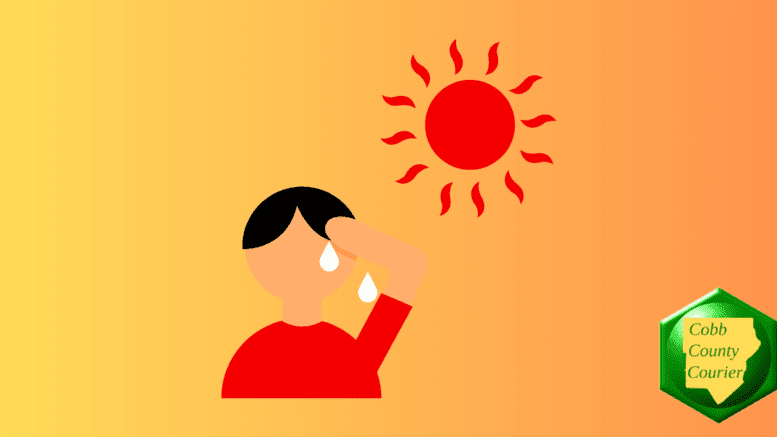By John A. Tures, Professor of Political Science, LaGrange College
It should have been one of my happiest memories. I was a new graduate student at Florida State University, and my friends and I were attending the first home game at FSU. The Noon game was a scorcher, but that was just part of the game, right? The Seminoles went up big over North Carolina State University, on their way to a win by more than 60 points. But the game nearly turned tragic, as a friend had too much to drink. She was packed in ice by rescue personnel underneath the stadium and should consider herself lucky.
What’s a Heat Dome? According to Spacefish (for those who engage in outdoor sports and recreation in Florida) “A heat dome is a weather phenomenon where a persistent area of high atmospheric pressure traps hot air underneath, similar to a lid on a pot, leading to prolonged and intense heat waves. This high-pressure system prevents cooler air from circulating in and hot air from escaping, causing temperatures to rise significantly and potentially break records.” And we’ve definitely had some of those, and will have more this Summer.
You probably also know about the heat index, which combines the temperature with the humidity level. Out West, where I grew up, we had hot temperatures, but low humidity in the deserts and mountains. In a phone conversation with the Courier, Mitchell Zaplatosch, an assistant professor of exercise science and sports management at Kennesaw State University, explains why a combination of heat and humidity is so dangerous.
“Normally you have your regular environmental temperature. What the heat index does is it captures the additional heat stress that you’ll feel from the added humidity, so it incorporates humidity into that perceived temperature feel, because with that greater humidity, it’ll feel hotter because you are less able to actually dissipate heat from your body, so you’re less able to have evaporation of your sweat. That’s a major cooling mechanism that the body has. So when it’s higher humidity, we’re not as good at dissipating that heat from our sweat evaporating into the air. So it makes it feel hotter because we’re less able to cool ourselves naturally with that sweating response. So heat index takes that into account. It’s going to feel hotter because you’re not able to regulate your body temperature as well due to that higher humidity.”
For this article, I consulted the American Red Cross and the National Weather Service.
We all know that you must drink water, but how much? The American Red Cross recommends nearly a gallon of water a day. As we should have done at the FSU game, you should avoid alcoholic drinks, as well as those exceptionally sugary and caffeinated. While working the All-Star Game’s 3×3 Home Run Derby, local officials showed us how bad these drinks can be for you. In addition to water, it’s not a bad idea to add a sports drink or snacks that can replace the salt you lose from sweat. Avoid salt tablets unless a doctor recommends taking them.
I hate to sound indelicate, but you can see what you need by what you pee. The darker the pee, the more water you need. It should be clearer if you are getting enough water and good liquids.
As I write this, we’re having our air conditioner examined. Make sure your cooling units and dehumidifiers are maintained well. If they aren’t working so well, go to places where you can stay cool, like the library, indoor shopping centers (not those “heat islands” in Florida), or a restaurant. Some have fans on in a room when it gets to be over 90 degrees, but the National Weather Service states, “Do not direct the flow of portable electric fans toward yourself when room temperature is hotter than 90°F. The dry blowing air will dehydrate you faster, endangering your health.”
Wearing Dri-Fit clothing might help, or other lightweight materials, rather than thicker ones. The National Weather Service recommends using sunscreen SPF 30 or higher, though I would opt for higher. I recommend the spray sunscreen, and don’t slather yourself with sunscreen cream, which can clog your pores. I ran a Memorial Day 5k in 100-degree heat after doing that, and I had some form of heat exhaustion afterwards.
Also, check in with others, especially those you know might be vulnerable. These can be older people, those with disabilities, and those with small children.
Make a plan with those you know. My sister-in-law and husband, in Columbus, and my wife and I have a pact. If one loses AC, we go to the other house. This can include cases of severe storms (like those hitting Georgia this week; check with NOAA, the Weather Channel, or AccuWeather) or the machine gives out. Have a “go bag” for all emergencies, so you are ready to go if disaster strikes, and you don’t have to pack it in the dark or extreme heat. Include those vital medications you might need (as one family member does).
It should go without saying that no one should leave a child, an elderly person (or any other human) or pet, in the car. You know not to do that, but every year, this happens. If you’re in a parking lot, keep your eyes peeled for such cases when you traverse the blacktop.
If you have workers who must be in the sun, familiarize yourself with what the Occupational Safety and Health Administration (OSHA) provides for the standards to follow.
According to the American Red Cross, “You can contact the Disaster Distress Helpline for free if you need to talk to someone. Call or text 1-800-985-5990.”
John A. Tures is a professor of political science at LaGrange College in LaGrange, Georgia. His views are his own. He can be reached at jtures@lagrange.edu. His “X” account is JohnTures2.
